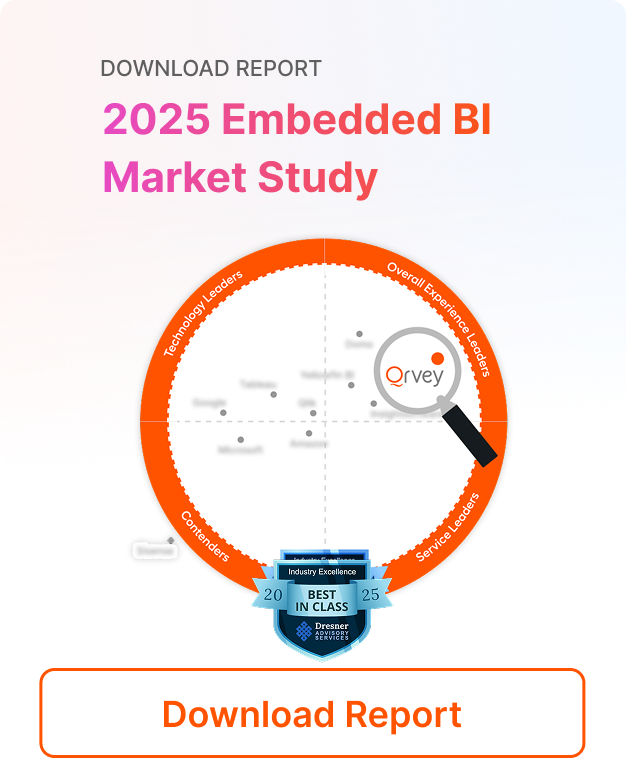Evaluating Embedded Analytics
Making the Right Choice for SaaS
Choosing the right analytics platform isn’t just a technical decision, it’s a strategic one. The resources in this Evaluation Center can help guide a confident decision.

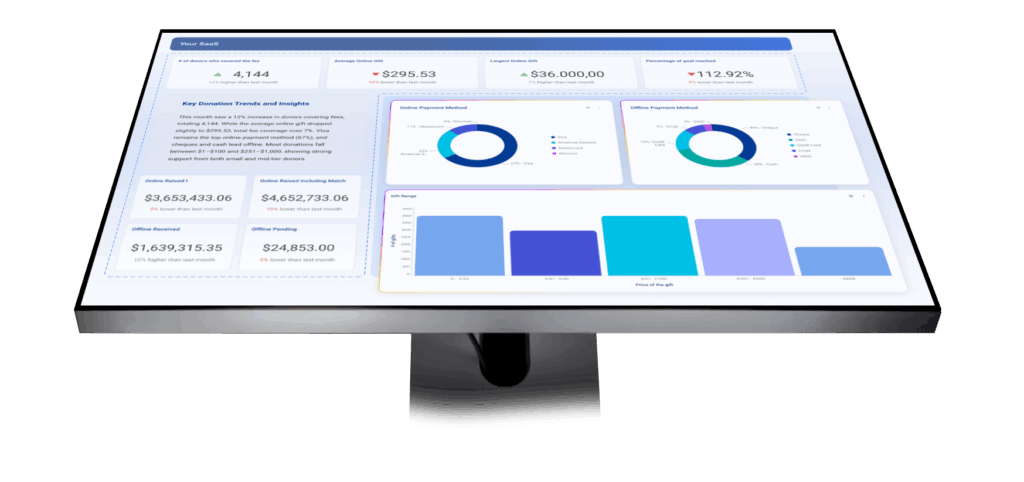
Trusted by Leading SaaS Companies






Embedded Analytics Evaluation Guide
Evaluate What Matters
Get a proven step-by-step framework for assessing analytics vendors, helping you cut through hype and identify the best fit for your software product.
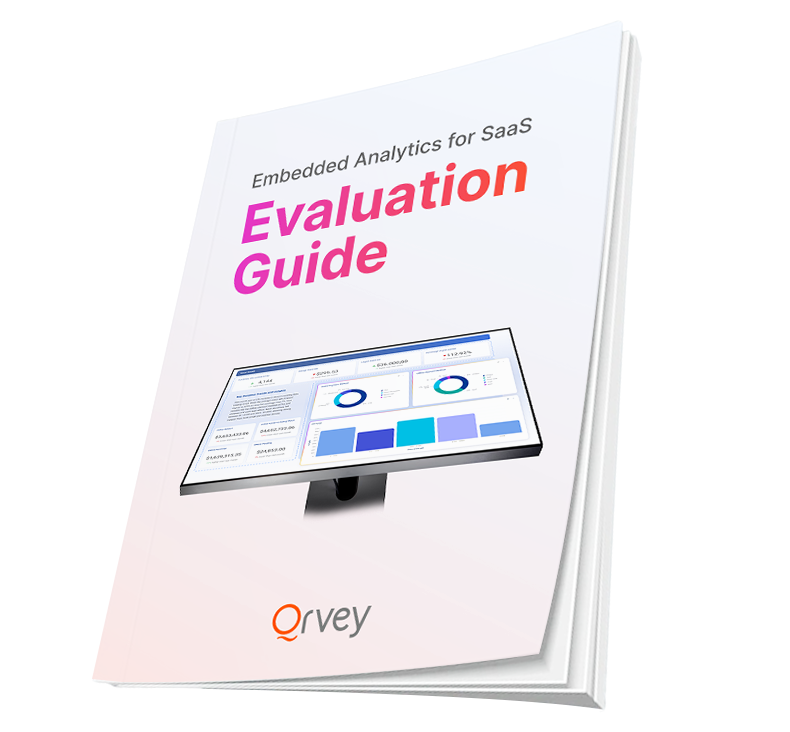
Interactive Vendor Scorecard
This interactive vendor scorecard is designed to save you time and help you focus on real-world requirements that matter most to your business.
We’ve done extensive market research on embedded analytics tools that claim to serve SaaS businesses. Our scoring system is meant to help you further evaluate each vendor’s true capabilities as it pertains to the unique needs of SaaS: multi-tenant, embedded, white labeled, self-service analytics capabilities.
Note: If the scorecard isn’t visible, clear your cookies and refresh the page.
Vendor Scorecard Template
You’ve tried our scorecard, now make it your own.
Customize this scorecard to include all the requirements and vendors you plan to evaluate, and share it with your team.
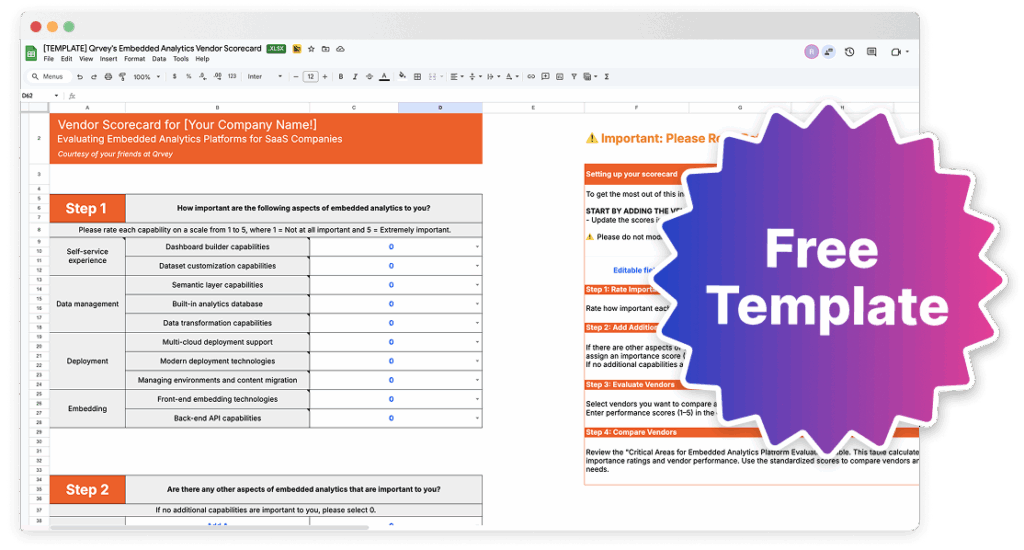
Dive Deeper into Embedded Analytics Requirements for SaaS
Beyond the Shiny Object: Evaluating AI
Why Self-Service Embedded Analytics is a Strategic Advantage
Why Multi-Cloud Deployment is Non-Negotiable
Semantic Layer: Bridging the Gap Between Data and Self-service
The Power of Dataset Customization
Scaling Embedded Analytics Requires Modern Deployment Models
Why Robust Environment Management is Crucial for Embedded Analytics
Your Embedded Analytics Platform Needs Its Own Data Engine
Data Transformation: The Backbone of Scalable Embedded Analytics
Semantic Layer: Bridging the Gap Between Data and Self-Service
When evaluating embedded analytics platforms, flashy dashboards and AI claims often steal the spotlight. But beneath the surface, one foundational capability determines whether your analytics experience will scale – or stall: data management.
Data management: the foundation for embedded success
Embedding charts is easy. Delivering a seamless, secure, and scalable analytics experience inside your SaaS product is not. That’s where data management comes in. Without it, you’re left stitching together brittle pipelines, managing tenant-level data access manually, and firefighting performance issues.
A strong embedded platform should:
- Handle multi-tenant data isolation natively
- Support data transformation and modeling without relying on external tools
- Offer governed access to metrics and dimensions across tenants
If your platform can’t do these, you’re not embedding analytics—you’re embedding technical debt.
The semantic layer is where data management meets Self-Service
A semantic layer translates raw data into business-friendly terms, so users can explore confidently without writing SQL or breaking logic. It is the bridge between raw data and user understanding.
Self-service isn’t just a UX feature. It’s a data architecture decision. Without a semantic layer, users are either overwhelmed by raw data or locked into static views. With it, they can build their own reports and explore new questions – without waiting on a data team.
But here’s the catch: a semantic layer without a data engine is incomplete. As our Embedded Analytics Evaluation Guide points out, semantic layer purists argue that analytics front-ends should never manage data directly. But in the real world, most SaaS companies don’t have perfectly optimized analytic databases.
Platforms like Looker offer a semantic layer (LookML) but lack a data engine, ETL, or multi-tenant support, forcing SaaS teams to fill in the gaps with custom infrastructure. That’s why pragmatic platforms combine semantic modeling with built-in data engines—to deliver performance and cost-efficiency without compromise.
When evaluating embedded analytics platforms, prioritize:
- A semantic layer that supports governed self-service
- Built-in data transformation and modeling
- A multi-tenant-aware data engine
- Deployment flexibility to match your infrastructure and compliance needs
If a platform can’t manage your data, it can’t manage your analytics.
For a deeper breakdown of how to evaluate these capabilities across vendors, consider reading our Embedded Analytics Evaluation Guide. It outlines the architectural tradeoffs that matter most—and the questions every SaaS team should be asking.
Download the Evaluation Guide to make a confident, future-ready decision.
Why Self-Service Embedded Analytics is a Strategic Advantage
For SaaS leaders looking to augment their platforms with embedded analytics, there are many aspects to consider—from data management to user experience. Among these, self-service capabilities stand out as a critical component. In this article, we take a closer look at what self-service means in the context of embedded analytics, and why it matters for SaaS success.
Bringing a self-service analytics experience to customers is no longer a nice-to-have—it’s a key differentiator for SaaS companies looking to win in their respective markets. Customers expect more than just access to data—they expect control. That’s where self-service embedded analytics comes in. It’s not just a feature; it’s a strategic advantage that empowers your users, reduces support overhead, and scales your product’s value across tenants.
To fully appreciate the value of self-service embedded analytics, it’s important to understand how its implementation in SaaS environments differs.
Self-Service embedded analytics for SaaS companies is different from traditional BI
Embedded analytics in SaaS applications isn’t just about visualizing data-it’s about empowering every customer and every user within those customers to explore, understand, and act on their data independently. That’s a tall order.
Unlike traditional BI tools designed for internal use, analytics in SaaS must operate in a multi-tenant environment, where each customer (or tenant) expects a personalized, secure, and seamless experience. This means:
- Each tenant’s data must be isolated and protected.
- The analytics experience must be customizable at the tenant and user level.
- The platform must scale across hundreds or thousands of tenants without performance trade-offs.
- Analytics must be embedded directly into the SaaS product, not bolted on as a separate tool.
These requirements make embedded analytics for SaaS fundamentally different-and far more complex-than traditional analytics. But when done right, they unlock powerful benefits: deeper product engagement, reduced support burden, and a more data-driven customer base.
These unique demands reshape what “self-service” truly entails in a SaaS context—going far beyond basic dashboard access.
What Self-Service embedded analytics for SaaS customers really means
Self-service analytics allows tenant users to build dashboards, customize visualizations, and even modify datasets—all without relying on your product or engineering teams. This autonomy is a game-changer. It enables customers to tailor analytics to their unique business needs, which in turn frees your team from an endless stream of change requests.
But there’s a catch: most analytics platforms are optimized for single-tenant environments. In multi-tenant SaaS, the same features may be limited, unavailable, or require significant customization. That’s why evaluating self-service capabilities in a SaaS context requires a different lens—one that accounts for scale, security, and seamless user experience.
Among the many facets of self-service, dashboard building stands out as a critical capability—one that directly impacts both customer satisfaction and internal efficiency.
Dashboard building capabilities are key
Without true self-service, your product and engineering teams become the default support desk for every analytics request. Every dashboard tweak, dataset adjustment, or visualization change drains valuable time and resources—time that could be spent on core product development or strategic initiatives.
A strong dashboard builder flips that dynamic. It shifts ownership to your customers, enabling them to build what they need, when they need it. This not only improves their experience but also reduces the operational burden on your internal teams. The result is a more scalable, efficient model for delivering analytics across your customer base.
When assessing dashboard builder capabilities, especially in a multi-tenant SaaS context, here are key criteria to consider:
- Multi-Tenant Readiness: Can the platform isolate data and configurations per tenant? Does it support tenant-specific customization without compromising performance or security?
- True Self-Service: Can a non-technical user build and modify dashboards independently? Look for drag-and-drop interfaces, dataset editing, and intuitive UX.
- Embedded Parity: Are all features available in the embedded experience, or are some locked behind a separate platform?
- Role-Based Access: Can users securely share dashboards within their organization, with granular permissions?
- Scalability: Will the platform perform consistently as your customer base grows?
- Governance and Control: Does the platform offer admin oversight, audit trails, and usage analytics to help you manage adoption and compliance?
If you’re evaluating embedded analytics platforms for SaaS, don’t settle for a feature checklist. Use a framework built for SaaS. Our Evaluation Guide breaks down the four critical areas to assess—self-service, data management, deployment, and embedding—and helps you compare vendors based on what really matters.
Download the Evaluation Guide to make a confident, future-ready decision.
Unlocking a True Self-Service Analytics Experience: The Power of Dataset Customization
Self-service embedded analytics is a powerful promise: give your customers the ability to explore, visualize, and act on their data on their own terms. But that promise is only as strong as the data experience behind it.
While many platforms advertise self-service, they quietly limit what users can actually do—especially when it comes to customizing the datasets. And that’s a problem. In SaaS, where every customer has unique metrics, naming conventions, and workflows, the ability to tailor datasets isn’t optional—it’s essential. Yet many vendors don’t offer this capability because their multi-tenant architecture wasn’t built to support it. That’s not just a technical limitation—it’s a strategic failure.
The heart of self-service: customizing the datasets
Most analytics platforms offer some surface-level interactivity—filtering, drilling down, maybe even rearranging widgets in dashboards. But true self-service goes deeper. It means giving users the ability to:
- Rename fields to match their business language
- Create calculated fields or metrics
- Build entirely new datasets from existing ones
- Tailor data structures to reflect their workflows
This level of control transforms analytics from a static reporting layer into a dynamic decision-making engine. It’s what separates a good embedded analytics experience from a great one.
As outlined in our Embedded Analytics Evaluation Guide, dataset customization is a powerful differentiator. It enables customers to shape your application around their business—not the other way around—enhancing both flexibility and satisfaction.
Why most vendors cannot offer dataset customizations
Here’s the uncomfortable truth: many analytics vendors don’t support dataset customization in multi-tenant environments. And it’s not because they don’t want to—it’s because their architecture won’t let them.
Most general-purpose BI platforms were designed for internal, single-tenant use. Multi-tenancy was bolted on later, often through workarounds like:
- Creating a separate data model (e.g., Elasticube) per tenant
- Using rigid namespace structures tied to cloud accounts
- Limiting tenant access to pre-built dashboards only
These approaches create trade-offs. For example, Sisense requires a separate Elasticube per tenant to enable dataset customization, which significantly increases management complexity and cost. Looker and ThoughtSpot don’t offer embedded dashboard builders at all in multi-tenant mode.
As a result, SaaS companies are forced to choose between operational efficiency and customer empowerment—a choice they shouldn’t have to make.
The consequences of limiting dataset customization are not trivial
When dataset customization is restricted, the impact goes far beyond a missing feature—it undermines the entire self-service promise. Customers are forced to work with rigid, pre-defined data models that don’t reflect their business logic, terminology, or KPIs. This leads to frustration, disengagement, and a reliance on your support or engineering teams for every minor change. Over time, this bottleneck slows down customer insights, inflates operational costs, and erodes trust in your analytics offering. Worse, it signals to customers that your product isn’t built for their growth or complexity. In a competitive SaaS market, that’s a risk you can’t afford.
What to ask when evaluating platforms
If you’re evaluating embedded analytics solutions, ask these questions:
- Can tenant users create and manage their own datasets?
- Are custom fields, metrics, and naming supported at the tenant level?
- Can users customize datasets directly within the embedded experience—or are they forced to switch to a separate vendor platform to do so?
- Does the platform support co-mingled data models with secure, isolated customization?
If the answer to any of these is “no,” you’re likely looking at a platform that wasn’t built for SaaS.
Dataset customization isn’t a bonus – it’s the baseline
Dataset customization isn’t a bonus—it’s a baseline for modern SaaS analytics. If your platform can’t support it, your customers will feel it. And so will your team.
Platforms that support tenant-level dataset customization unlock a more scalable, satisfying, and differentiated analytics experience. They empower your customers to move faster, reduce your support burden, and help your product stand out in a crowded market.
To help you evaluate platforms with this in mind, download our Embedded Analytics Evaluation Guide. It outlines the four critical areas to assess—self-service, data management, deployment, and embedding—and includes specific questions to uncover architectural limitations before they become your problem.
Download the Evaluation Guide to make a confident, future-ready decision.
Why Multi-Cloud Deployment is Non-Negotiable
When SaaS companies embed analytics, they’re not adding a dashboard—they’re extending their product. That means analytics must meet the same standards as the rest of the application: scalable, secure, compliant, and deployable wherever the product lives. This is where multi-cloud deployment becomes a non-negotiable strategic requirement.
Embedded analytics is a product, not a tool
SaaS companies don’t embed analytics for internal reporting—they embed it as part of their customer-facing experience. That means analytics must follow the same deployment, security, and compliance requirements as the rest of the application. If your analytics platform can’t deploy where your product lives, it’s not truly embedded.
Many platforms restrict deployment to a single cloud provider or operate only as SaaS. This limits your ability to align analytics with your infrastructure strategy, creates friction in regulated industries, and introduces risk around data residency and sovereignty. As our Embedded Analytics Evaluation Guide points out, platforms that lack multi-cloud support often rely on outdated deployment models like manually managed servers, which is costly and hard to scale.
Multi-cloud deployment isn’t just about cloud choice
Multi-cloud deployment isn’t about internal flexibility—it’s about meeting external demands. Enterprise customers often have strict infrastructure policies. Regulated industries require data to stay within specific environments. Global customers expect compliance with regional laws.
If your analytics platform can’t deploy in the environments your customers trust, you’re either losing deals or building costly workarounds. Multi-cloud support means you can say “yes” to more customers, faster—and without compromising your product architecture.
Beyond compliance, multi-cloud deployment directly impacts how quickly you can onboard new customers, launch new regions, and scale usage. A modern embedded analytics platform should support containerized deployment, CI/CD pipelines, and seamless migration across environments.
If your embedded analytics layer can’t be deployed and managed like the rest of your product, it slows everything down—from development to delivery.
When evaluating embedded analytics platforms, don’t just ask about features – ask about deployment. Specifically:
- Can the platform be deployed across multiple cloud providers?
- Can it migrate content across environments without manual effort?
- Is it designed to align with your SaaS product’s infrastructure and compliance needs?
If the answer is no, the platform may be built for internal dashboards—not for SaaS products.
Check out our Embedded Analytics Evaluation Guide to learn how to assess the self-service experience, data management capabilities, deployment architecture, and embedding capabilities across embedded analytics vendors—and make sure the platform you select is built to scale with your product.
Download the Evaluation Guide to make a confident, future-ready decision.
Scaling Embedded Analytics Requires Modern Deployment Models
Embedded analytics has become a cornerstone of product strategy for SaaS companies. It’s not just about visualizing data—it’s about delivering actionable insights exactly where users need them, within the flow of their daily operations. But delivering this vision hinges on how embedded analytics platforms are deployed.
The problem with legacy deployment models
Traditional business intelligence (BI) platforms were designed for centralized, monolithic environments. They relied on manually managed servers or virtual machines, often requiring extensive configuration, rigid infrastructure, and high operational overhead.
These legacy models struggle to meet the demands of modern SaaS environments, especially when it comes to:
- Multi-tenancy: Legacy platforms often lack secure, scalable multi-tenant data management. This forces SaaS providers into brittle workarounds that compromise performance and security
- Environment management: Migrating content between development, staging, and production environments is cumbersome, slowing down release cycles and increasing risk.
- Scalability and performance: Manual server management limits elasticity, making it difficult to respond to spikes in usage or scale across customer bases.
For SaaS companies, these limitations translate into slower innovation, higher operational costs, and frustrated customers.
The rise of modern deployment technologies
Modern deployment technologies—such as serverless computing, containerization (e.g., Kubernetes), and cloud-native architectures—offer a transformative alternative. These approaches enable embedded analytics platforms to be:
- Scalable: Serverless and containerized deployments can scale automatically based on demand, ensuring consistent performance without manual provisioning.
- Multi-cloud Ready: Platforms can be deployed across multiple clouds (AWS, Azure, GCP), or even within the customer’s own cloud environment, aligning with their infrastructure and compliance needs.
- Efficient: Developers can focus on business logic rather than infrastructure, accelerating time-to-market and reducing operational overhead.
These modern deployment technologies also support advanced features like dynamic user hierarchies, API-driven customization, and seamless integration with backend services. For SaaS providers who need to support multi-tenancy, dynamic user hierarchies, and real-time data access, modern deployment technologies are a strategic requirement.
Deployed vs. SaaS-managed embedded analytics: a strategic choice
SaaS-managed platforms may seem convenient at first glance. They’re hosted by the vendor, require minimal setup, and promise quick access. But beneath the surface, they come with serious limitations: restricted customization, limited control over infrastructure, and potential compliance risks due to third-party hosting. For SaaS companies that need to scale, differentiate, and meet complex customer requirements, these constraints quickly become roadblocks.
Deployed embedded analytics, on the other hand, puts you in control. You choose where and how the platform runs—whether in your cloud or across multiple environments. This flexibility is essential for multi-cloud and hybrid deployments, security and compliance alignment, deep customization, scalability and performance.
Deployed solutions aren’t just more powerful—they’re more strategic. They allow SaaS providers to embed analytics as a core product capability, not just a bolt-on feature. That means faster innovation, differentiated analytics experiences, and future-proof for the platforms.
Build for what’s next
If you’re evaluating embedded analytics for your product, here are a few strategic questions to guide your decision-making:
- Where will my analytics platform be deployed—and who controls it?
- Can I support multi-tenant environments without compromising performance or security?
- How easily can I customize the analytics experience for different user roles or customers?
- Will my deployment model scale as my customer base grows?
- Does my solution align with my customers’ compliance and infrastructure requirements?
Modern deployment isn’t just about technology—it’s about embedding analytics that works for your product, your customers, and your future.
By moving beyond legacy BI models and embracing cloud-native, serverless, and containerized architectures, SaaS companies can deliver analytics that are scalable, secure, and deeply integrated into their products.
To help SaaS leaders like you navigate this decision with confidence, we’ve created a comprehensive Evaluation Guide—a practical framework for SaaS companies to assess embedded analytics platforms based on real-world needs, including deployment, embedding, self-service, and data management.
Whether you’re building your first analytics experience or replacing a legacy solution, this guide will help you ask the right questions and make the right choice.
Download the Evaluation Guide to make a confident, future-ready decision.
Why Robust Environment Management is Crucial for Embedded Analytics
Embedded analytics is no longer a bolt‑on; in modern SaaS, it is a product itself. When your customers open your application, the dashboards they see, the metrics they trust, and the alerts they act on are as central to their experience as any core feature. That reality elevates analytical content into first‑class product artifacts that must move through development, staging, and production with the same rigor you apply to other parts of your product.
The stakes are high
A modified measure in your semantic layer, a renamed column in your data warehouse, or a seemingly innocuous filter tweak can cascade into broken pieces, contradictory KPIs, and support tickets that undermine confidence.
In multi‑tenant contexts, the risk is even sharper: misapplied row‑, column‑, or schema‑level security can leak data across tenants, eroding trust you may never fully regain. When the platform acknowledges distinct dev, test, and prod stages, your team can validate functionality and security in representative conditions before any customer sees a change.
The hidden complexity of environment management
In traditional BI platforms, migrating dashboards, data models, and configurations between environments is often manual, error-prone, and slow. This creates bottlenecks in release cycles and increases the risk of inconsistencies or outages in production. For embedded analytics, where analytics is tightly woven into the product experience, these risks are magnified.
When migration is ad‑hoc, reality gets messy fast. Teams export and import dashboard bundles by hand, maintain brittle spreadsheets of dependencies, and rely on tribal knowledge to remember which tenant groups map to which roles. Over time, the release process devolves into “cross‑your‑fingers” deployments. Dependency explosions and mismatched models guarantee a release‑control headache, especially as the number of dashboards and contributors grows.
Embedded analytic solutions need to support environment management
Capable embedded analytic solutions built for SaaS acknowledge these challenges explicitly, supporting deployment across distinct environments and treating automated content promotion as a foundational capability, not a convenience. That alignment with the software development lifecycle is what preserves trust at scale, speeds iteration, and prevents analytics from becoming a drag on your roadmap.
The payoff extends beyond engineering hygiene. Reliable promotion protects customer trust, which is the currency of adoption and renewal. Automated deployment and environment‑aware workflows let product teams ship new KPIs, localized experiences, and monetized tiers quickly without creating operational drag.
If you’re assessing embedded analytics platforms, ask:
- Can I automate content promotion across environments?
- Does the platform support environment-specific configurations?
- Is there built-in support for CI/CD and version control?
- How easy is it to validate and roll back changes?
- Will this solution scale across multiple tenants and deployments?
The bottom line is simple. In SaaS, analytics migrations are product releases. Choose a platform and a practice that deploys within your environment, supports dev/test/prod natively, and automates content promotion with versioning, validation, and rollback. Do that, and you’ll move faster with more confidence, protecting the trust that makes analytics valuable in the first place.
Check out our Evaluation Guide to learn how to assess the self-service experience, data management, deployment, and embedding capabilities across embedded analytics vendors to make sure your customer-facing analytics are built to scale with your product.
Download the Evaluation Guide to make a confident, future-ready decision.
Your Embedded Analytics Platform Needs Its Own Data Engine
In embedded analytics, performance and cost aren’t just technical concerns—they’re product decisions. And the most overlooked factor driving both is whether your analytics platform includes a built-in analytic database.
This isn’t a backend detail. It’s a make-or-break capability that determines whether your analytics experience will scale with your product—or collapse under its own complexity.
What is a built-in analytic database – and why it matters
At its core, a built-in analytic database is a native data engine embedded directly within the analytics platform. Unlike external databases or cloud warehouses, it’s purpose-built for analytical workloads—optimized for fast queries, high concurrency, and multi-tenant environments.
This matters because embedded analytics isn’t just about displaying charts—it’s about delivering insights in real time, at scale, and without compromising your infrastructure or budget. A built-in engine gives you the control and efficiency needed to make analytics a seamless part of your product.
Why built-in beats bolt-on
Many platforms claim flexibility by relying on external databases or your existing data warehouse. But that flexibility comes at a cost:
- Every query hits your production system
- Every dashboard load competes with your core app
- Every new tenant adds cost, latency, and risk
- You’re responsible for performance tuning, indexing, and caching
A built-in analytic database flips this model. It’s optimized for read-heavy, multi-tenant workloads. It isolates analytics from your operational systems and gives you control over performance and cost-without forcing you to re-architect your stack.
Performance and cost control: built-in analytics database
SaaS products grow. That’s the goal. But with every new customer, your analytics layer takes on more load. If your platform depends on external databases, performance may degrade as concurrency increases. A built-in analytic database handles concurrent queries across tenants without bottlenecks, and supports caching, pre-aggregation, and in-memory processing. It is designed to keep dashboards fast—even during peak usage.
And just as important, it helps you control costs. External compute and storage can quickly become unpredictable and expensive. A built-in engine helps you avoid runaway compute and storage costs and reduces cloud egress and API call charges. This predictability is especially critical for SaaS businesses with usage-based pricing models or tight margins.
When comparing embedded analytics platforms, don’t stop at the UI. Ask:
- Does this platform include a built-in analytic engine?
- Can it isolate and optimize workloads across tenants?
- Will it help us control cost as we scale?
If the answer is no, you’re likely building around limitations instead of scaling with confidence.
For a deeper breakdown of how to evaluate this and other critical architectural capabilities, refer to our Embedded Analytics Evaluation Guide. The guide provides a framework for assessing self-service experience, data management, deployment, and embedding capabilities across vendors to help ensure your embedded analytics solution is built to scale with your core product.
Download the Evaluation Guide to make a confident, future-ready decision.
Data Transformation: The Backbone of Scalable Embedded Analytics
In embedded analytics, what happens before the dashboard loads is just as important as what users see on screen. For SaaS companies managing multi-tenant environments, data transformation isn’t just a backend task—it’s a strategic capability that determines whether your analytics platform can scale, perform, and empower users.
Data transformation is more than just a processing step
Data transformation refers to the process of reshaping raw, often messy, source data into a format that’s optimized for analysis. This includes cleaning inconsistencies, joining disparate datasets, creating calculated fields, and applying tenant-specific filters.
In a multi-tenant SaaS context, these transformations must happen dynamically, securely, and often in real time. Without this capability, analytics becomes rigid and fragile—dependent on external ETL pipelines, manual workarounds, and constant engineering support.
Multi-tenant SaaS demands built-in data transformation
Many embedded analytics platforms treat transformation as someone else’s problem. They assume your data is already clean, modeled, and ready to query. But in reality, SaaS companies deal with fragmented schemas, evolving data models, and tenant-specific logic that can’t be hardcoded.
Without native transformation capabilities, teams are forced to preprocess data outside the analytics layer, manage tenant-level logic manually, and maintain brittle infrastructure that doesn’t scale. This slows down iteration, increases engineering overhead, and limits your ability to deliver differentiated experiences to your customers.
Platforms with built-in transformation capabilities change that. They allow you to apply business logic directly within the analytics layer, dynamically segment data by tenant, and support both co-mingled and isolated data models.
The unmatched advantage: built-in data transformation and analytics database
Data transformation is powerful on its own—but when paired with a built-in analytics database, it becomes a force multiplier.
When the transformation engine runs close to the data, latency drops, complexity disappears, and performance improves. You’re no longer pushing compute to an external warehouse or relying on your production database to serve analytical queries. Instead, you gain full control over how data is shaped, stored, and served—per tenant, per use case, and per product experience.
This combination—native transformation plus a built-in data engine—is what unlocks real-time, governed, and cost-efficient analytics at scale.
When evaluating embedded analytics platforms, ask whether the platform:
- Supports native data transformation
- Can apply logic per tenant, securely and at scale
- Pairs transformation capability with a built-in analytics database
Check out our Evaluation Guide to learn how to assess self-service experience, data management, deployment, and embedding capabilities across embedded analytics vendors to ensure your embedded analytics platform is built to scale with your product.
Download the Evaluation Guide to make a confident, future-ready decision.
Beyond the Shiny Object: Evaluating AI Capabilities for Embedded Analytics
In the race to embed AI into analytics platforms, it’s tempting to focus on flashy features and novel capabilities. But true innovation lies in a platform’s ability to evolve. The most important principle when evaluating AI in embedded analytics is not what the platform can do today—but how well it can adapt tomorrow. A future-ready platform is one that’s architected to seamlessly integrate emerging AI technologies, enabling continuous improvement and delivering lasting value to customers.
The real benchmark? Flexibility over novelty.
AI is advancing rapidly, and what feels revolutionary today may be outdated next quarter. That’s why the smartest product leaders evaluate platforms not by their current AI features, but by their architectural agility—how easily they can adopt and operationalize new AI capabilities.
A platform built for extensibility can plug in new models, support evolving interaction patterns, and expose those capabilities through APIs and workflows. This flexibility ensures that your analytics experience remains relevant and competitive, even as the AI landscape shifts.
AI-enabled self-service experience starts with the right foundation
AI is a powerful enabler of customer self-service—but only when the underlying platform is built to support it. When embedded correctly, AI can transform dashboards into dynamic, conversational interfaces. It can surface insights proactively, automate workflows, and empower users to explore data in natural language.
But these benefits are only possible if the platform gets the fundamentals right:
- Multi-tenancy must be secure, scalable, and tenant-aware.
- Semantic layers must support governed self-service across diverse user roles.
- Data engines must be performant and context-sensitive.
Without these solid foundations, even the most impressive AI features will fail to deliver meaningful value to your customers.
Many platforms boast AI features but falter under real-world conditions. General-purpose BI tools often struggle with multi-tenancy, leading to brittle workarounds and compromised security. If your platform can’t manage your data architecture, it can’t manage your analytics experience.
This is why platform evaluation must begin with architecture—not aesthetics. A well-designed foundation ensures that AI features are not just impressive, but impactful.
The Rise of Agentic Analytics
Analytics is evolving from a passive reporting function into an active, decision-driving force. At the heart of this transformation is agentic analytics—a new paradigm where AI agents don’t just assist users, they take initiative. These agents monitor data continuously, identify patterns, surface insights, and even trigger actions, all without waiting for a user to ask.
Agentic analytics is defined by its ability to combine conversational interfaces with generative capabilities. Users can interact with data using natural language, and the system responds by creating dashboards, generating summaries, or suggesting next steps. But it doesn’t stop there. These agents are designed to proactively discover insights—flagging anomalies, surfacing trends, and identifying opportunities that might otherwise go unnoticed.
What makes agentic analytics truly powerful is its integration with workflow automation. Insights aren’t just visualized—they’re acted upon. Whether it’s sending alerts, updating CRM records, or initiating support tickets, the system closes the loop from insight to execution. And because these agents operate within a multi-tenant, event-driven architecture, they can deliver real-time decisions tailored to each customer environment.
For SaaS companies, agentic analytics is the next frontier in customer empowerment and operational efficiency.
What to watch for
As you evaluate platforms, keep an eye out for:
- Extensibility: Can the platform integrate new AI models and protocols without major rework?
- Transparency: Does the vendor clearly disclose roadmap and architectural limitations?
- Agentic Readiness: Is the platform API-first, multi-tenant, and event-driven?
These are the signals of a future-proof analytics strategy—one that empowers your customers and keeps your product ahead of the curve.
Whether you are building your embedded analytics strategy from the ground up or refining an existing approach, our Embedded Analytics Evaluation Guide is a must-read. It is designed to help SaaS product leaders like you assess platforms not just for what they offer today, but for how well they’ll serve your customers tomorrow.
Download the Evaluation Guide to make a confident, future-ready decision.
Questions to Ask an Embedded Analytics Vendor
Evaluating Embedded Analytics?
Get our top 12 hard-hitting questions to ask vendors during an evaluation.
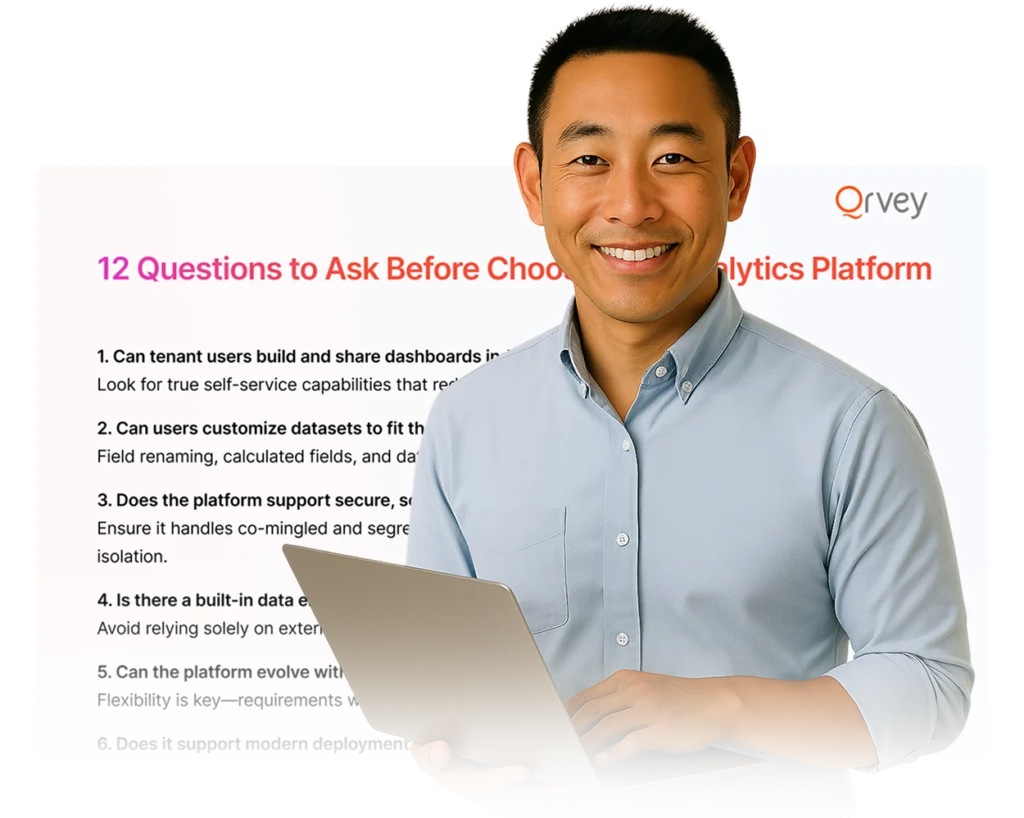
See what our partners have to say

Herman Haynes
CIO @ Global K9 Protection Group
Adding Qrvey to our business was like turning on a light switch.


Ryan Quackenbush
Senior PM @ JobNimbus
We can’t speak highly enough of the stellar team at Qrvey. Within months of deploying Qrvey, JobNimbus achieved 70% adoption among large
enterprise users.


Dadou Jahanbani
CTO @ Impexium
Qrvey allowed Impexium to go to market quickly and get analytics into the hands of our customers.


Srinivasa Sridharan
CTO @ Setvi
Excellent product and customer support.
asasasasasasas sasasasas







See Qrvey in Action
Learn about Qrvey’s embedded analytics platform and get quick answers to your questions by booking a guided product tour with our experts.





